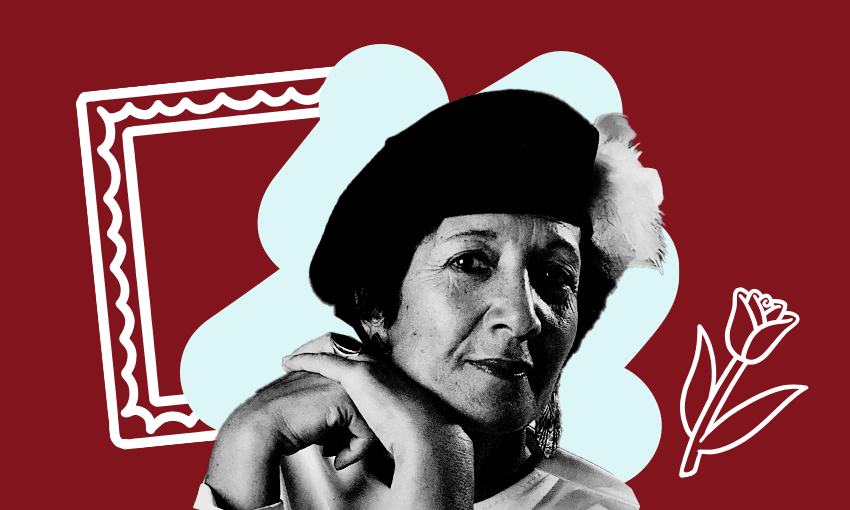Summer read: She was the driving force behind the Māori language petition that led to the revitalisation of te reo in Aotearoa, and a tireless campaigner for indigenous rights for decades after. Now a series of events to honour Hana Te Hemara are being held near her Taranaki birthplace.
First published August 29, 2022
Fifty years ago, in wet and bitterly cold weather, Hana Te Hemara and an army of elders and activists marched on parliament to deliver the Māori language petition. The date was September 14, later to become Māori language day and subsequently the centrepiece of te wiki o te reo Māori.
The 1972 petition, spearheaded by Te Hemara and signed by 33,000 Māori and Pākehā, called for the introduction of Māori language and culture curriculum in schools nationwide. It read:
“We the undersigned, do humbly pray that courses in Māori language and aspects of Māori culture be offered in all those schools with large Māori rolls and that these same courses be offered as a gift to the Pākehā from the Māori in all other New Zealand schools as a positive effort to promote a more meaningful concept of integration.”
The petition came at a time when a changing economic landscape had swept Māori into the cities and the world was aflame with protests about civil rights, women’s rights and the Vietnam war. It was also a time when, disconnected from their tribal territories, more and more whānau were unable or unwilling to pass te reo Māori down to the young. Some had had the language literally beaten out of them, while others, witnessing this cruelty, believed their whānau would be safer without it.
It was out of these conditions that Ngā Tamatoa was born. The name itself, “the young warriors”, was gifted to the group by the late Ranginui Walker after meeting with a number of members and discussing their inspirations and passions. These were as varied as the members themselves. Some were keen on violent revolution, while others more philosophically passive. Ideologically diverse though the group was, there was at least one shared belief: Tama tū tama ora; tama noho tama mate – Tamatoa! (To stand is to live, to sit down is to die.)
It is unsurprising, then, that the dynamic leaders who emerged were a pair who could sympathise with these many beliefs and at the same time had the mana to command members’ respect. These leaders were Syd Jackson and his wife, Hana Te Hemara.
Born in 1940 in Puketapu, Te Hemara was initially raised with te reo, before the Catholic colonial school system took away her native tongue. She is remembered by those who worked alongside her as a star, a person of great passion, an extraordinary orator and someone who could stir an audience. Much of this was true of Te Hemara even as a child, when she gained a reputation among her 11 siblings as a bossy boots and a goodie two shoes. Her natural leadership at home continued well into adulthood, when she would return home from Auckland and share with her mother and siblings what she had learned about New Zealand history and how she planned to fix all that had gone wrong.
So that’s exactly what she did. She spent years in the spotlight, collecting praise from her peers and criticism from mainstream media for her efforts to revitalise the Māori language, Māori culture and te ao Māori more generally. Te Hemara went house to house up and down Aotearoa collecting signatures for the Māori language petition. But she wasn’t averse to more confrontational action too. She rushed the Treaty grounds dressed in black kākahu in 1971, marking the first modern-day protest at Waitangi, and then returned the following year, daring those who opposed her to carry through on their threats to wring her neck. Four years later she was a key member of the Takaparawhā Bastion Point occupation.
Not only did Te Hemara protest and petition, she built too. She was a tireless champion for Māori business and creativity, forming the first Māori business association, organising Te Kopu Designers’ Award for Māori designers, working alongside Hone Tuwhare to set up the first Māori artists and writers conference, and driving the establishment of Te Kōhanga Reo. There are now more than 450 Kōhanga Reo around Aotearoa, and over 50,000 pre-schoolers have been taught te reo Māori me ngā tikanga since the first kura was established in 1982.
Te Hemara passed in 1999. Her teina, Rāmari Maipi, was later asked what she believed her sister’s legacy would be. “That’s simple, it was her fight for the language. Just the fact that she stood up and fought… Besides that, [her] grandkids speak the language – that’s its own legacy.”
And so it was that Hana Te Hemara, who did not possess the language herself, became one of its greatest champions and the mother of te wiki o te reo Māori.
In celebration of Hana Te Hemara’s life, the work of Ngā Tamatoa, and the 50th anniversary of their petition to parliament, a series of events are being held in Ngāmotu throughout September. More information can be found at iamhana.nz.
Airana Ngarewa is a Māori political affairs reporter, creating public interest journalism funded through NZ On Air.
Follow our te ao Māori podcast Nē? on Apple Podcasts, Spotify or your favourite podcast provider.

